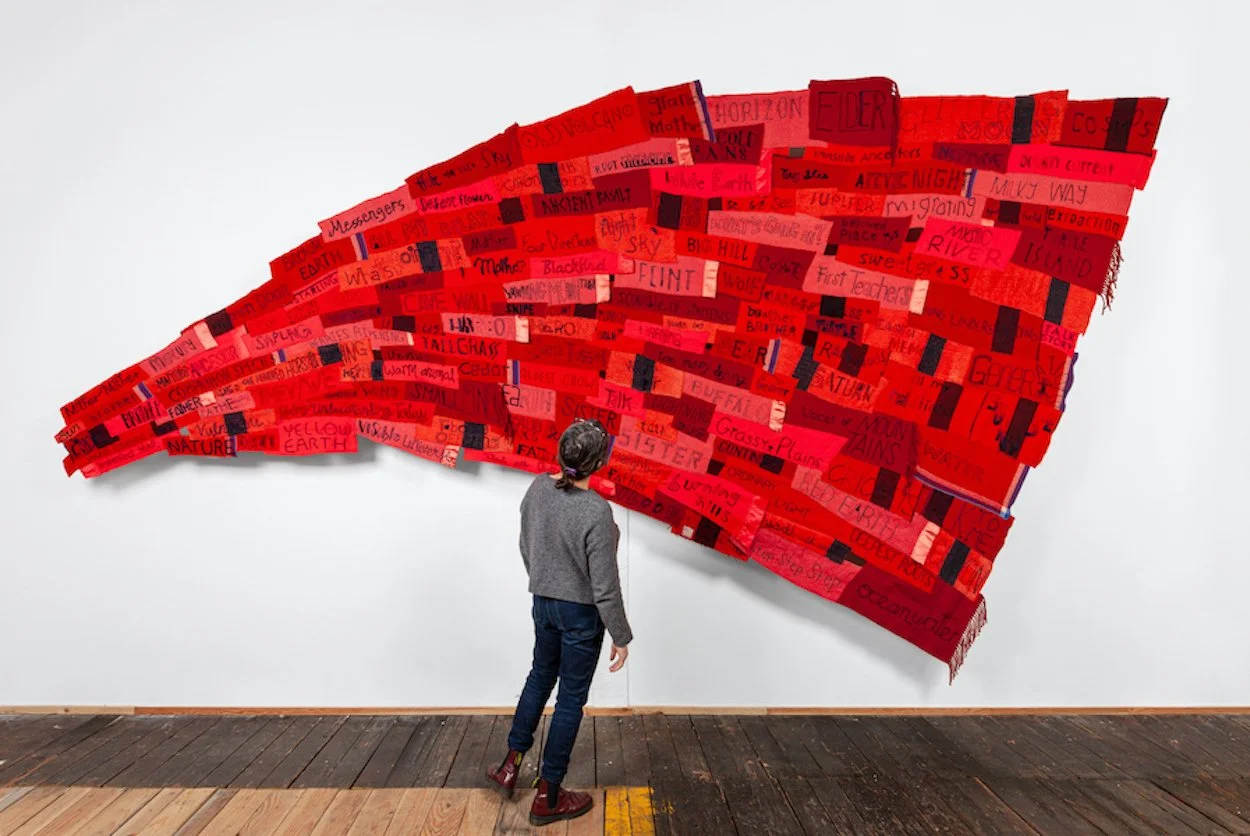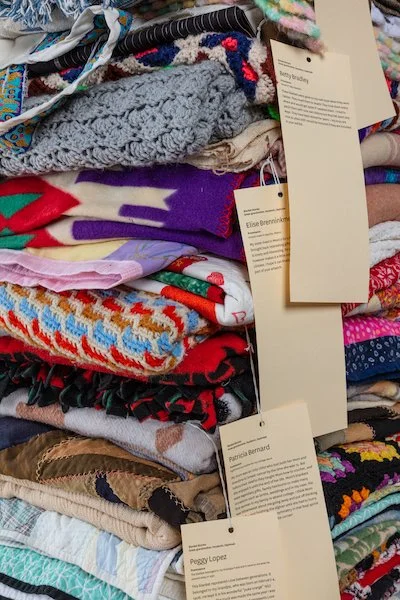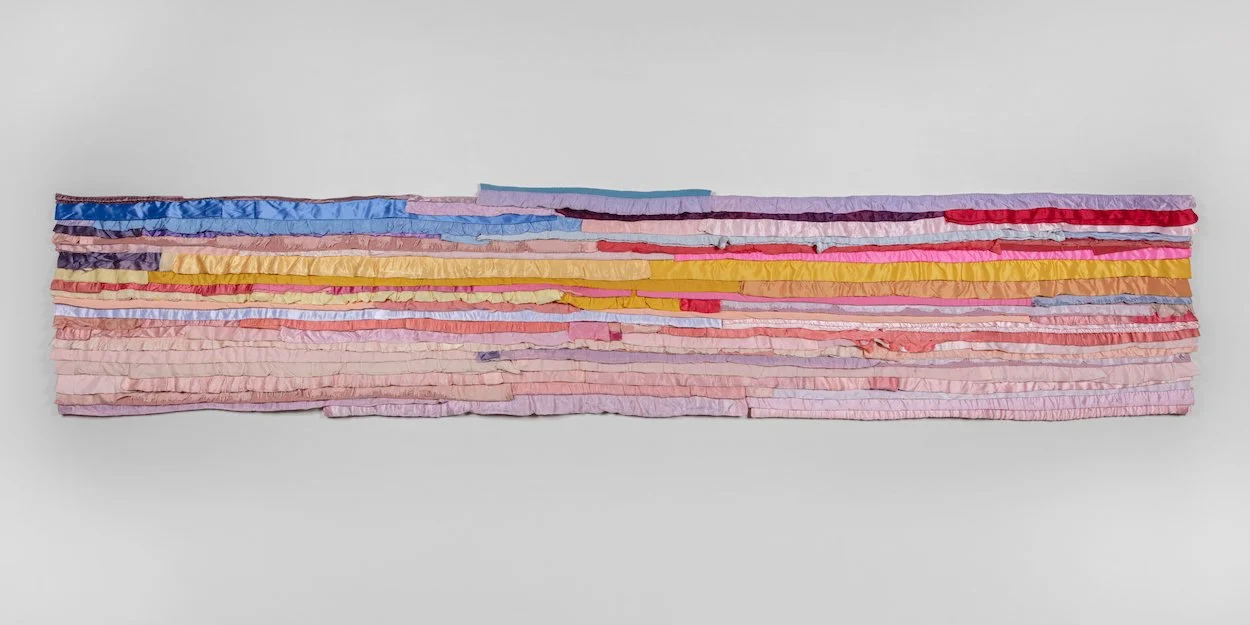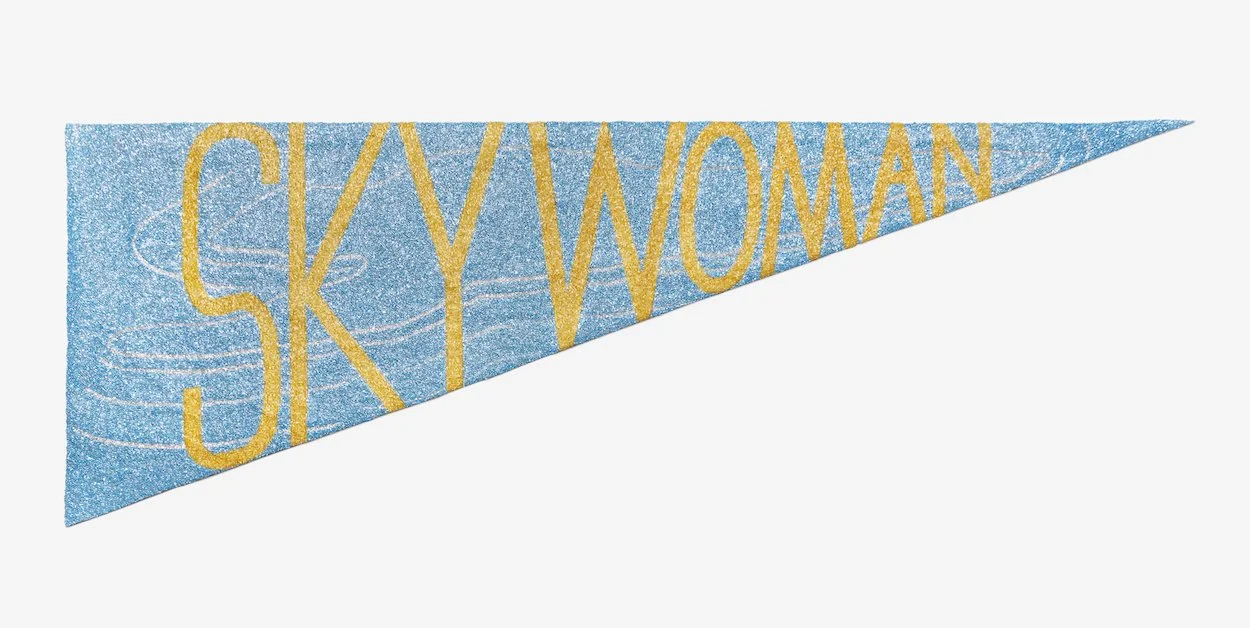Native Song: Marie Watt's Communal Incantations in Fabric
Published in Art in America, November 3, 2021
By Glenn Adamson
Marie Watt: Companion Species: Cosmos, Sunrise, Flint, 2021, reclaimed wool blankets, embroidery floss, thread, 115 by 220 inches.
ALL PHOTOS KEVIN MCCONNELL
“Once, there were songs for everything.” Marie Watt, whose solo show “Companion Species (At What Cost)” runs through January 9, 2022, at the Hunterdon Art Museum in Clifton, New Jersey, is speaking in her Portland, Oregon, studio, with the debris from making fabric sculptures and installations all around her. She is talking to me about craft, writing, art, and history. Before long, the conversation turns to music, songs both ancient and modern. She’s just quoted a member of the Mvskoke (Creek) Nation, Joy Harjo—current poet laureate of the United States and the first Native American to be so honored—as a way to begin explaining her own artwork. Three years ago, Watt began to incorporate fragments of text into her work, which is sometimes completely beaded over.
On one wall of the studio was a wide banner-like hanging, still in progress, that read “Turtle Island,” a term variously used by her own people, the Seneca (historically, one of the woodland nations of the Haudenosaunee Confederacy), to designate the earth, North America, or the idea of homeland. Another recent work reads “our teeth make refuge for our tongues,” another quotation from Harjo. Actual song lyrics get into the work too, notably from Marvin Gaye’s “What’s Going On.” Written half a century ago, during the Civil Rights movement, the Vietnam War, and the American Indian occupation of Alcatraz, its lyrics nonetheless feel all too relevant now. Watt has stitched its phrases into her work—”mother, mother”; “brother, brother”; “we don’t need to escalate”; “right on, baby”—as if the song were already playing, and she were just joining in.
Watt describes her use of existing text as “a call back in time and a call forward, a twinning of language.” Difference within repetition. That formula is also intrinsic to craft—the slight irregularities imparted by the human hand—and it lies at the heart of Watt’s practice. Hers is an art of accumulation, bead by bead, stitch by stitch, neon tube by neon tube, taking its life from the variations that happen within recurrence. Two or three times a year, she stages public events to initiate a new artwork, turning the making process into a sort of social gathering. (The artist will host a sewing circle at Marc Straus gallery in New York on December 8.) To some extent this is simple pragmatism, the contemporary art version of a barn-raising, many hands making the work light. But Watt also cherishes the instant community brought about by this collective effort, the creation of a shared, intergenerational, multicultural endeavor. Crowdsourcing complicates her own authorship, and brings what she describes as a cadence to the work, “what’s present around the whole table, not just what is in front of each maker.”
Blanket Stories: Great Grandmother, Pandemic, Daybreak (detail), 2021, reclaimed blankets, cedar base, 108 by 38 1/4 by 40 inches.
Watt also employs diversity and repetition in her choice of motifs, traversing time and culture, connecting disparate experiences. Blankets are the most important of these; she has worked with them for some twenty-five years, after earning her MFA in painting and printmaking at Yale University. (As a student she had used corn husks, which were “not met with much warmth or encouragement.”) She has stacked blankets high, arranged them in concentric arcs, cut them apart and sewed them together again, cast them in clear resin and obdurate iron. For years, she imposed a strict limit on herself, spending at most five dollars on each secondhand blanket, buying them in large quantities, just as a painter might buy new tubes of oil or acrylic. But these objects came with stories. “I quickly learned from their tags that they migrate,” she says. ”Some blankets have people’s names in them; others have nibbled bits, and mended parts.”
These incidental microhistories attest to the latent cultural capital of these apparently low-value commodities. For many children, a blanket is the first object of attachment. Even as adults, we remain on intimate terms with them. And in Native American culture, blankets are symbolically potent. Watt’s own family observes a custom of giving them as gifts to mark major life events. More broadly in Native communities, blankets have been associated with both trade and tradition, to the point that whites intent on forcibly assimilating Indigenous people disparagingly referred to those who retained their customs intact as “blanket Indians.” Her use of the material reflects that history, while also indicating an openness to other perspectives: in her hands blankets are a common fabric, both literally and figuratively.
Companion Species (A Distant Song), 2021, reclaimed satin bindings, industrial felt, thread, 32 1/2 by 168 inches.
Watt’s inclusive approach is a knowing riposte to modernist abstraction, which was often claimed as a new universal language, despite its obvious Euro-centricity (which entailed ignoring precedents such as tilework and textiles throughout the world). She counters this dominant narrative with another, based not on transcendent form but commonplace experiences, like being tucked in at night. Another new work, underway in her studio when we spoke, contains nothing more than seam bindings—the strips of satin that run along blanket edges—in various states of wear. Horizontally arranged in a spectrum running from pink to gold to blue, the composition suggests a sunset. It prompts the thought that a blanket under the chin is a sort of psychological horizon, with a dreamscape on the far side. There’s an unmissable reference here to postwar American paintings by the likes of Mark Rothko, Morris Louis, and Kenneth Noland. Watt domesticates the idiom of these canonical artists without retreating an inch from their ambition to capture the sublime. The work is so wide that when you stand at its center, you cannot see its edges. “It envelops you,” Watt says, “just like an actual sunset does.”
Skywalker/Skyscraper (Sunrise), 2021, reclaimed blankets, steel I-beam, cedar blocks, 88 by 30 by 30 inches.
The sky is the conceptual backdrop for another series that Watt is currently developing, which stages a material juxtaposition between blankets and steel I-beams, the latter painted in bands. Vertical in orientation, they somewhat suggest the totem poles of Indigenous peoples of the Northwest, like the Coast Salish and the Tlingit. The I-beams also allude, once again, to modernism—the sculpture of Anthony Caro and Mark di Suvero—and to architecture. Watt has had in her mind the celebrated “Skywalkers” of the Mohawk nation (another woodland people of the Haudenosaunee), who have worked far above the streets of Manhattan, fitting and riveting together the armature for high-rise buildings. “They’re up there,” Watt comments, “in conversation with the sky, a mythic and magical space, where man has always aspired to hang out—a space of wonder.”
If there are two types of artists—stones, who simply roll ahead, gathering no moss, and snowballs, who gather meaning gradually as they create—Watt is definitely the latter. She tends to work around a topic, touching upon it in suggestive, overlapping ways. Thus her explorations of the celestial also invoke the Haudenosaunee legend of the Sky Woman. The idea of mothering led Watt not only to Marvin Gaye, but also to a common symbol of ancient Rome showing Romulus and Remus being suckled by a she-wolf in the wilderness. The artist is appreciative of ancient representations of this scene—“this non-biological mother, with her emaciated ribcage, nourishing these founding demigods, offering her body as a shelter, though you feel too that she could be ferocious.” In Native American belief wolves can be strong protective figures, too, so this is yet another example of Watt looking for connection, soaring right past conventional boundaries and classifications. She points out that most Indigenous languages do not even have a word for art. Aesthetics are not divorced from bare necessity. Similarly, we human beings are understood to exist in a relationship (hopefully harmonious) with animals, plants, the environment, and not in our own separate realm.
Forerunner, 2020, vintage Italian glass beads, industrial felt, thread, 39 by 102 inches.
This is what it means to have a song for everything: It’s a matter of belonging, which Watt continually offers in her work. When she inscribes pieces with terms like “Turtle Island” or “Sky Woman,” for example, some viewers may not know the reference. But they may wonder, and that opens up a space of potential connection. “It’s a prompt to say it out loud,” she says, ”and that can be attached to a way of seeing that is experiential. I am walking on Turtle Island, it is the sound beneath my feet, it is what I return to.” There is an extraordinary generosity here, which takes its full meaning only against a tragic backdrop, the displacement of Native people from their ancestral lands. Watt holds this history in view, while also making signs that mark a conceptual territory, one that we can all inhabit, in a spirit of mutuality. Gordon Bettles, a Klamath elder, once told her: “My story changes when I know your story.” And so with Watt, and all of us, together.




